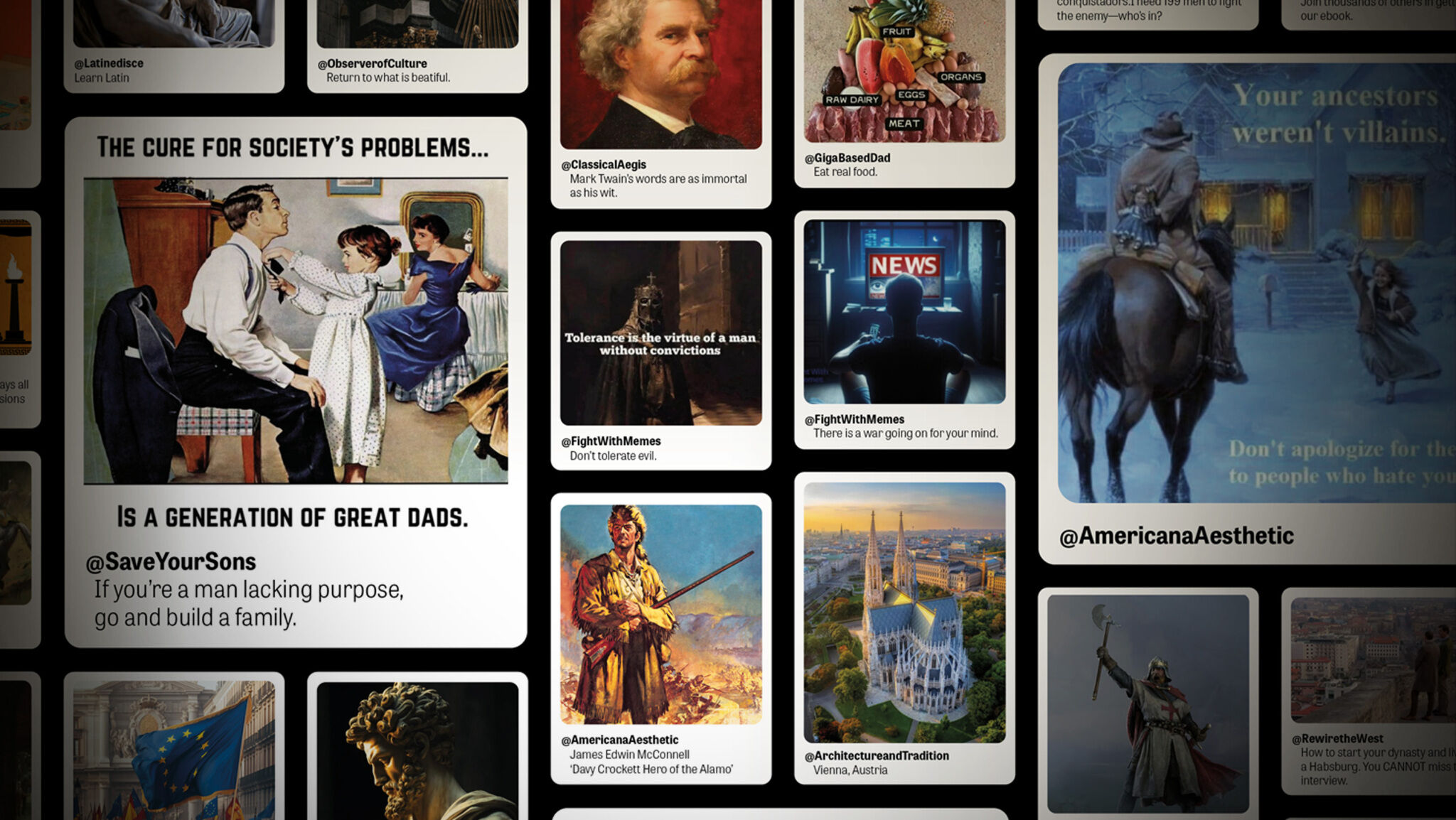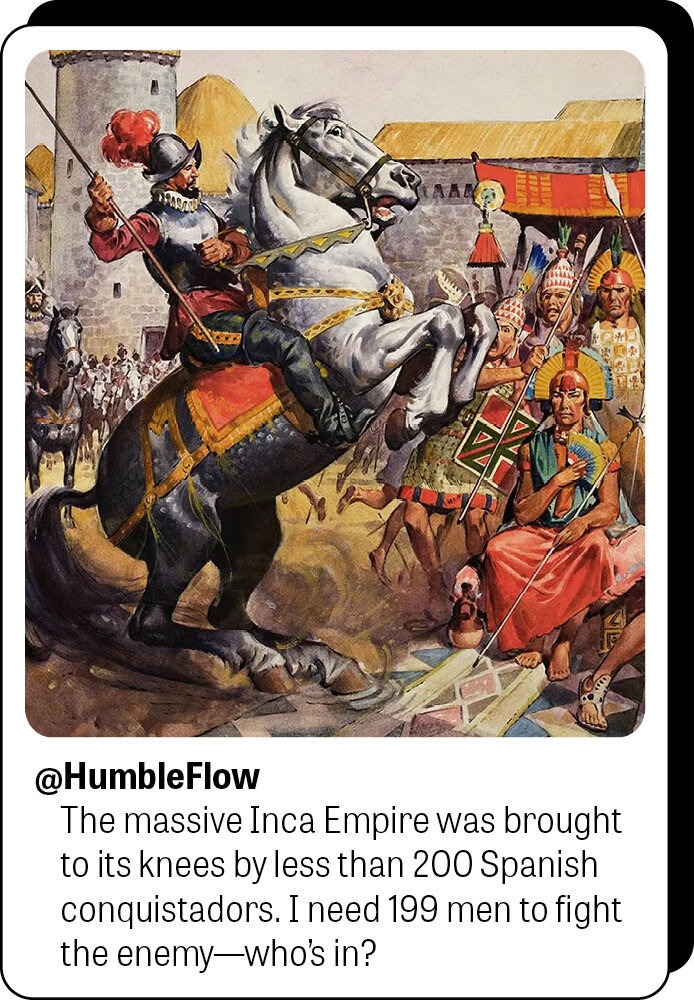The Old Made New

The Old Made New
Ladies and gentlemen, a new movement is present within our society, and I wonder what you make of it. It is a resistance movement, a rebellion. It’s not an uprising against tradition and history—but against the incessant destruction of tradition and history.
This uprising doesn’t look like the freedom fighters in a blockbuster film. It looks a lot more like eating meat, lifting weights, learning skills, reading the Bible, attending church services, buying a house, committing to one woman, living traditional roles, raising children, and looking the establishment leftist radicals in the eye and telling them, “No.”
This movement is advanced by different people of different ages in different ways, from the frivolous to the political to the profound: plaid, boots, wide-brimmed hats or Year 2000 cargo pants and polo shirts over here; flip phones, vinyl records and old cameras trending as novelties over there. New automobile models and nameplates derived directly from the old. Art, design, music, forums and entire subcultures that celebrate the “retro,” the “steampunk,” the “vintage,” the “old ways.” People “detoxifying” from their smartphones, bending over backward to obtain more natural nutrition, speaking out about masculinity and femininity without apology.
Modernity permeates the Western world with its evolutionary purposelessness, ceaseless sensual gratification, technological glorification, perpetual novelty, sacrosanct self-superiority, political stasis, self-destructive sexuality and promise of a future without accountability—and without independence, autonomy, tradition or liberty, without purpose, nor families, nor sexes, nor even, for many, the desire to perpetuate humanity.
The hypotheses of Darwin, the ideology of Marx and the psychology of Freud are the new orthodoxy. The priests of modernity dominate, the world they have made is ugly, and now some people are reacting.

In different ways and to different degrees they are recognizing materialism as mundane, so-called liberality as oppression, empiricism as empty, rationalism as incomplete, feminism as false, pornography as slavery, sexual mutilation as mutilation, and ideologies dependent upon accusations of “Nazi” as fraudulent. At this point, simply to openly appreciate what Europe, Britain and America have contributed to civilization is an act of defiance. Politicians and other censors assert that the Western record, landscape paintings, mathematics and hiking outdoors is “racist.” Even if all they desire is a woodstove and some raw milk, traditionalists are the new revolutionaries.
You see some of the desire for tradition reflected in the occasional feature film or television series portraying men on a medieval quest, or sailing the open sea, or banding together in warfare. You might glimpse it on a political or news program. If you look for it in podcasts or social media, where New York and Hollywood budgets and executives are not a prerequisite, you will find it in abundance.
Some of these new traditionalists are bold enough to devote their daily lives to resuscitating dying arts, trades and traditions: from beekeeping, gardening and homeschooling to blacksmithing, carpentry, farming, ranching, masculinity and fatherhood for the boys and men; to baking, canning, cooking, nutrition, sewing, childcare, homemaking, femininity and motherhood for the girls and women. And many more who are not so bold as to live off the grid on a homestead with a milk cow, nonetheless “like, share and subscribe” to the increasing number of commercial and personal media channels that document and portray these traditional ways of life.
We love it, and there are good reasons why.
The new traditionalism goes far beyond building and crafting: It necessarily extends to beliefs and family. Parents now understand some of the scope, sequence and subversion with which modern schools and universities are indoctrinating their children. Many have protested, removed teachers or school board members, passed fresh laws to ban that which is new and protect that which is old, and taken the major step of schooling their own children in their own homes.
A significant number of private schools, charter schools and home schools are adopting curricula based on the classical model. By one estimate, 1 million American schoolchildren are now learning the classics in this way. Meanwhile, a number of wealthier British parents who want their children to receive a proper education send them all the way to schools in India where history, logic, rationality, the classics, uniforms and respect for authority are core curricula—a traditional educational model that, ironically, first arrived in India with the British.
We are looking for something. We have looked around, we have looked ahead, and now we are looking back.
And when you look back, there are worlds to see: The entire heritage of Western civilization.
Behold
Ironically, this revival is perhaps most apparent online. The new traditionalists use new tools to capture the ethos of the 1970s father, the Apollo astronaut, the Norman Rockwell peace officer, the World War soldier, the pioneer, the Victorian naval captain, the French general, the classicist translator, the Roman legionnaire, the Greek thinker, the ancient warrior-poet, the philosopher king. They want to show you aged documents, grainy photographs, mechanical drawings, colorized videos and affectionate illustrations rendering the glories of the past and even the imagined retro-inspired future. They want to bring back to life the industrialists, the inventors, the soldiers, the composers and the nobles to look you in the eye before you scroll past. They want to bring you quotations that ring true from across the centuries and across the millenniums: Thomas Jefferson, Adam Smith, Horatio Nelson, Edmund Burke, Voltaire, John Locke, Isaac Newton, J. S. Bach, Martin Luther, Edward iii, William the Conqueror, Epictetus, Jesus Christ, Marcus Aurelius, Euclid, Constantine, Aesop, Thucydides, Alexander the Great, Moses.
They have account names like 0xAlaric, Alexander’s Cartographer, Aquinas Quotes, Aristos Revenge, Archeohistories, Architradition, Chivalry Guild, Classics mvp, Creation 24/7, Cultural Tutor, Defend the West, Dr. The Histories, Dynastus, Fanatical Monk, Histories Daily, Invictvs, Learn Latin, Medieval Scholar, Napoleon Bonabot, Rewire the West, Stoic Father, Svtcivni, Thinking West, Traditionalist Chad, Trad Wins, Unravel Virtue, Updating on Rome, Villa Grippa, Young Traditionalists and Western Exile. They love “hardcore history,” “the art of manliness,” the distinctions between exercising and training, the seamanship of the Vikings and the precepts of Stoicism. They will teach you facts about aqueducts, chivalry, composers, geometry, oils on canvas, masculine etiquette, orations, pavestones, philosophies, pikes, siege weapons, traditional families and the glories of Rome. Their call, for those who will hear it, is “Retvrn.”
One of the first accounts to stand out in this way, Culture Critic, is now followed by 1.5 million people who want glorious photos and factual explanations of architraves, plinths and spires, and pointed questions about why most elite modern Western architects fail, decline, or refuse to build dignified structures. Cards of History vividly illustrates and succinctly summarizes vignettes of the Western story from Allied troop drops to Dutch windmills to the discovery of the Dead Sea scrolls. Other accounts are provided by people who, though sometimes more interested in Internet fame than in their actual craft, will demonstrate to you how to change a tire, build a campfire, butcher a chicken, forge a sword, dress a stone, thatch a roof, saddle a horse, and swaddle a baby.
There are worlds we never knew. There are worlds that, as many online traditionalists have said, the modernists took from us.
Discern
Trudging through the culture war ruins, how refreshing it is to come across these rare individuals who reject the modernist apparatus and who openly appreciate past agriculture, apparel, architecture, engineering, handicrafts, music, painting, philosophy, science and sculpture, and who believe God exists. It’s a revitalizing respite from the dishonorable, gyrating, undignified, radical, seething anti-humanism of the present. It’s a special kind of connection, however small, with a brother in arms, because it joins us not only with each other but with something that is older and greater.
It’s worth remembering, though, that you and I must still exercise the virtue of discernment. We must love the things we love not because they are old, not because they are Western, not because they are ours, but because they are good.
Conservatism requires discernment between good and evil. It is not preservation of everything from the past because it is past. Rather it is the conservation only of what is good. And the evil always mixes itself with good. It is easy to overromanticize the past and overlook the costs of its triumphs and the blemishes of its heroes. Like the present, the past was permeated by both great achievements and great evils. That is exactly how we arrived at the present.
After all, the way of life leading to moral and intellectual self-reliance—then individual and civilizational self-destruction—was rightly named the tree of the knowledge of good and evil.

Our ancestors chose that way of life: judging evil and trying to generate good on our own. We willed to have that capacity, but we have never had it, neither in the peaks of the past nor, obviously, in the wasteland of the present. Good—and the ability to discern it from evil—can be generated only by the Creator of mankind.
What is the cause, the reviver of tradition might ask, that the former days were better than these? Solomon answers (Ecclesiastes 7:10), “You do not enquire wisely concerning this.”
Solomon experienced intellectuality, wisdom, wealth, authority, power and creativity to a degree that perhaps no other human being ever has. He built a glorious kingdom. He experienced the results of submitting to God’s will regarding good and evil, and he also experienced the results of substituting his own will instead—which led him, for all his many gifts, to hate life. Yet at the end of his days, he wrote words that echo through time to each one of us.
In Ecclesiastes 12:13, he takes us back not merely to the past but all the way back to the Creator and, moreover, to His laws defining right and wrong: “Let us hear the conclusion of the whole matter: Fear God, and keep his commandments: for this is the whole duty of man.”
Envision
And herein is real hope. This is where the glories and beauties of the past really come from! They come not from the greatness of certain men or certain institutions, but rather from the greatness of our beautiful, majestic, illustrious and glorious Creator. They come from the fact that we are created in the image of God (Genesis 1:26; Psalm 82:6; John 10:34; 20:17) with minds and bodies modeled after His and with His desire and dream to work together and create. Why are male and female beautiful? Why is family beautiful? Why is giving and building and achieving beautiful? For the same reason that these things came into existence in the first place: Because they come from the Creator God!
This is why certain parts of the past are, rightly, refreshing. They are clues that, if you trace them back to their true source, will lead you to the source of every good thing in every aspect of human life.
The former days were better insomuch as the former generations lived by the Creator’s laws of cause and effect, honored their father and mother, and did not kill, steal, lie or covet. They were better insomuch as those generations diligently applied their God-given gifts to learn and apply the physical laws of creation and produce artwork, music, inventions, buildings, cities, civilizations. They were evil insomuch as they disobeyed the fundamental laws of love toward God and love toward neighbor.
The same Creator and the same laws of cause and effect exist for us today. When we sow seeds of truth, beauty, elegance, majesty, virtue and righteousness, we reap harvests we can be proud of. In fact, God states in the Holy Bible that, like a loving Father, He will open up the windows of heaven to pour blessings onto us, our families and our posterity to the point that “there shall not be room enough to receive it” (Malachi 3:10).
God is laying seeds for a future whose glories—familial, agricultural, architectural, artistic, literary—are in some ways foreshadowed by the very best of what human beings have produced throughout history but that will transcend even those.
The Bible specifically states that rivers will dry up in certain places, emerge in others, new forests will grow, prairies will spread, barren places will turn green, and streams will flow. Animals and plant life will flourish. People will be freed from the evils that plague the body, as well as the evils that plague the mind. They will homestead, homeschool, farm, ranch, garden, grow orchards, build neighborhoods, invent tools, play sports, make music, advance education, invent technologies, create commerce, build cities, construct infrastructure.
They will learn from their Creator and His laws how to truly conserve the good and reject the evil. The “great conversation” in which humanity’s historians, philosophers, warriors, leaders and poets have engaged over the millenniums will finally be purified from its confusion, frustration, self-will and evil. A new conversation will begin between minds and hearts that are building on a true foundation.
Many, past and present, have stood in awe of the great works of Alexandria, Rome, Tenochtitlan, Istanbul, Paris, Manhattan and other cities. The Bible asserts that they—and you—will see greater works than these, more luminous than the Taj Mahal, more functional than the World Trade Center, more monumental than the pyramids.
These achievements will arise from peoples who are neither inflicted with subjugation nor infected with sin. The creators, the builders, the designers, the growers, the masters will be people more wholesome, more intelligent, more creative, more kind and more sincerely joyful than the most beautiful Instagram post or AI image ever contrived. They will be peoples as diverse from one another as their homelands, yet all joined together in prizing sincerity, truth, love and worship of the one true God. They will be joined together with each other, with their fathers and mothers, brothers and sisters, grandparents, cousins, friends, co-workers and neighbors. They will live as we were born to live.
Do certain things from the distant and recent past stir something in you? Do you crave a world where we finally understand what makes those things great, where the good is finally freed from its mixture with evil?
Yes, look at the past and its glories. Draw on the judgment of the Creator—rather than your own judgment—to discern that which is good from that which only appears so. When next you behold one of these all-too-rare and partially sullied artistic, constructive, botanic, inventive, societal or interpersonal beauties of the past, recognize what it is you are looking at. You are looking at evidence of your own Creator, of His laws of cause and effect, and of what the future for His creations can and will be. Beauty comes from its Creator, and He created human beings for the very purpose of sharing in it, enhancing it, adding our own touches to it, covering the globe with it, and more.
Return all the way through the past to the beginning, and you will actually find yourself ascending into a dazzling future.

